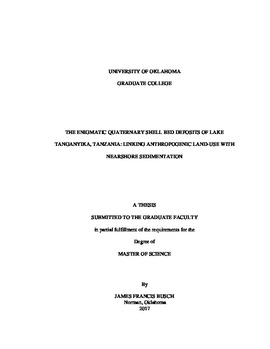| dc.description.abstract | Extensive deposits of carbonate shell-rich sediments in the nearshore environment (< 30 m water depth) of Lake Tanganyika, Africa, form a unique and important habitat for a diversity of endemic crabs, fish, sponges, and bryozoa. Anthropogenically-induced alteration of the hinterland from deforestation, burning of land, and agricultural activities threaten this crucial habitat through sediment pollution of the littoral environment. In the Mahale Mountains region (Tanzania), we examined the sedimentology of the shell-beds to test whether their heterogeneity is related to onshore disturbances within three moderately-sized watersheds (> 100 km2). Here, we suggest that observed onshore watershed disturbances result in sediments that are muddier with a higher percentage of clay in the area offshore of the Lagosa and Rukoma river watersheds compared to the area offshore of the largely unaltered Katumbi river watershed. Widespread burning of land, agricultural land-use, and the torrential rains of the wet season are causal factors that result in significant increases in fine-grained clastic sedimentation, increased fluvio-deltaic sediment plume size, and increased delta shoreline progradation. In areas most affected by sedimentation, littoral sponges are largely absent, and we speculate that other important benthic organisms that inhabit the shell beds are also negatively impacted by the influx of fine-grained clastic sediment. The discovery of a small population of Neothauma tanganyicense offshore of the relatively unaltered Katumbi river watershed suggests that the shell beds’ heterogeneity could be related to anthropogenic land-use and its effect on the occurrence of shell-bed forming gastropods. | en_US |
